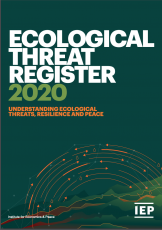Understanding ecological threats, resilience and peace
The first edition of Ecological Threat Register (ETR) by the Institute for Economics and Peace (IEP) measures the ecological threats faced by 157 independent states and territories and provides projections to 2050.

Topics covered in the ETR include population growth, water stress, food insecurity, droughts, floods, cyclones, rising temperatures, and rising sea levels. The report uses IEP’s Positive Peace framework to identify areas where resilience is unlikely to be strong enough to adapt or cope with these future shocks.
The ETR places threats into two major clusters: resource scarcity and natural disasters. The resource scarcity domain includes food insecurity, water scarcity, and high population growth. At the same time, the natural disasters cluster measures threats of floods, droughts, cyclones, sea-level rise, and rising temperatures.
The ETR identifies three clusters of ecological hotspots, which are particularly susceptible to collapse:
- The Sahel-Horn belt of Africa, from Mauritania to Somalia;
- The Southern African belt, from Angola to Madagascar;
- The Middle East and Central Asian belt, from Syria to Pakistan.
These countries compete for scarce resources, which creates conflict. The conflict, in turn, leads to further resource depletion. These countries are more likely to experience civil unrest, political instability, social fragmentation, and economic collapse.
While high resilience regions, such as Europe and North America, have superior coping capacities to mitigate the effects of these ecological threats, they will not be immune from large flows of refugees. Refugee influx, in turn, can cause considerable unrest and shift political systems.
There are 141 countries exposed to at least one ecological threat between now and 2050. The 19 countries with the highest number of risks have a population of 2.1 billion people. Approximately one billion people live in countries that do not have the resilience to deal with the ecological changes expected.
The countries with the largest number of people at risk are Pakistan, with 220 million people, and Iran with 84 million people. In such circumstances, even small events could spiral into instability and violence, leading to mass population displacement, which would negatively impact regional and global security.
The countries at the highest risk also face food insecurities and crisis-level water demands.
